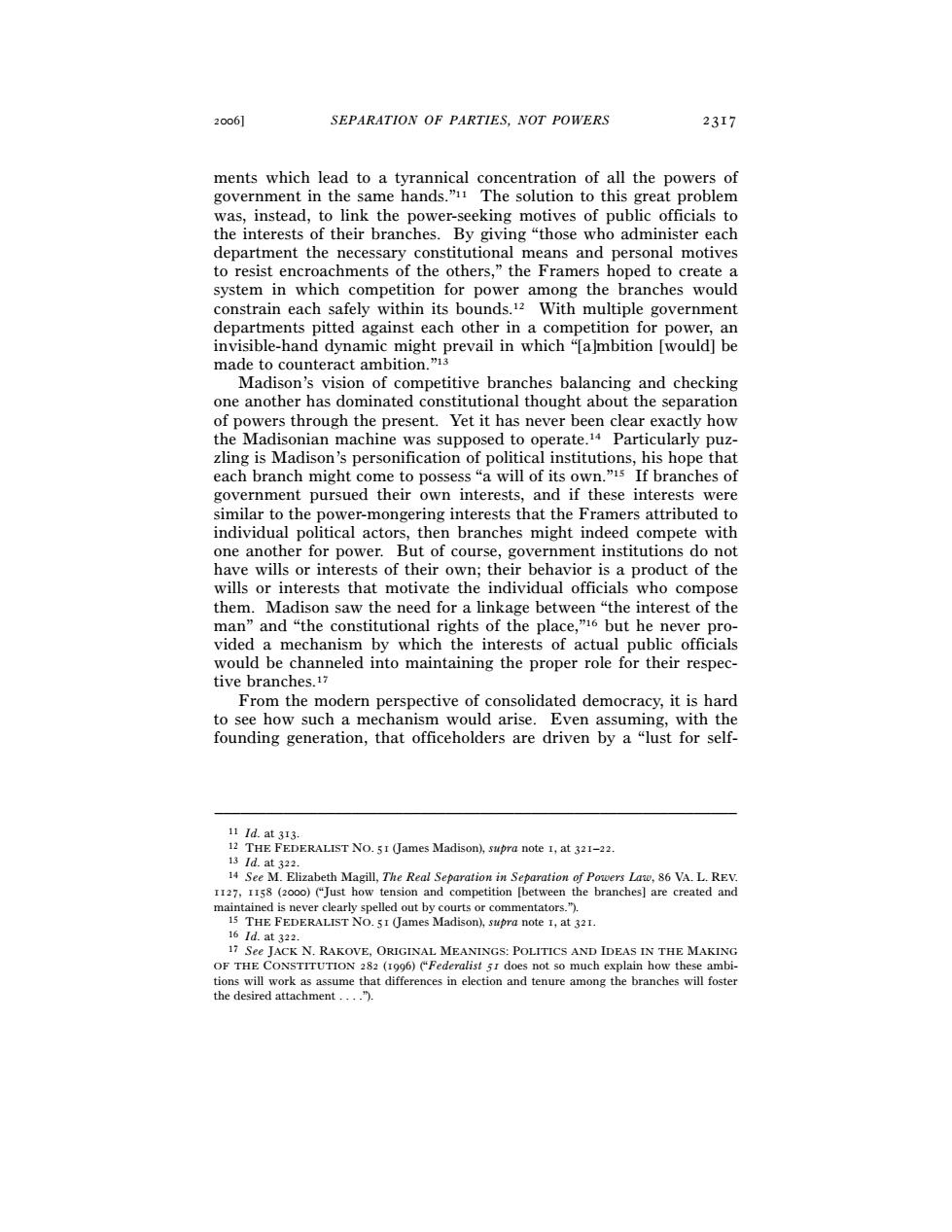正在加载图片...

2o06] SEPARATION OF PARTIES,NOT POWERS 23I7 ments which lead to a tyrannical concentration of all the powers of government in the same hands."11 The solution to this great problem was,instead,to link the power-seeking motives of public officials to the interests of their branches.By giving "those who administer each department the necessary constitutional means and personal motives to resist encroachments of the others,"the Framers hoped to create a system in which competition for power among the branches would constrain each safely within its bounds.12 With multiple government departments pitted against each other in a competition for power,an invisible-hand dynamic might prevail in which"[almbition [would]be made to counteract ambition.13 Madison's vision of competitive branches balancing and checking one another has dominated constitutional thought about the separation of powers through the present.Yet it has never been clear exactly how the Madisonian machine was supposed to operate.14 Particularly puz- zling is Madison's personification of political institutions,his hope that each branch might come to possess "a will of its own."15 If branches of government pursued their own interests,and if these interests were similar to the power-mongering interests that the Framers attributed to individual political actors,then branches might indeed compete with one another for power.But of course,government institutions do not have wills or interests of their own;their behavior is a product of the wills or interests that motivate the individual officials who compose them.Madison saw the need for a linkage between "the interest of the man"and "the constitutional rights of the place,"16 but he never pro- vided a mechanism by which the interests of actual public officials would be channeled into maintaining the proper role for their respec- tive branches.17 From the modern perspective of consolidated democracy,it is hard to see how such a mechanism would arise.Even assuming,with the founding generation,that officeholders are driven by a "lust for self- 11 Id.at 313. 12 THE FEDERALIST No.5I (James Madison),supra note 1,at 321-22. 131d.at322. 14 See M.Elizabeth Magill,The Real Separation in Separation of Powers Law,86 VA.L.REV. II27,I158 (2o00)("Just how tension and competition [between the branches]are created and maintained is never clearly spelled out by courts or commentators."). 15 THE FEDERALIST No.5I (James Madison),supra note 1,at 321. 16Id.at322. 17 See JACK N.RAKOVE,ORIGINAL MEANINGS:POLITICS AND IDEAS IN THE MAKING OF THE CONSTITUTION 282 (1996)("Federalist 5r does not so much explain how these ambi- tions will work as assume that differences in election and tenure among the branches will foster the desired attachment....").2006] SEPARATION OF PARTIES, NOT POWERS 2317 ments which lead to a tyrannical concentration of all the powers of government in the same hands.”11 The solution to this great problem was, instead, to link the power-seeking motives of public officials to the interests of their branches. By giving “those who administer each department the necessary constitutional means and personal motives to resist encroachments of the others,” the Framers hoped to create a system in which competition for power among the branches would constrain each safely within its bounds.12 With multiple government departments pitted against each other in a competition for power, an invisible-hand dynamic might prevail in which “[a]mbition [would] be made to counteract ambition.”13 Madison’s vision of competitive branches balancing and checking one another has dominated constitutional thought about the separation of powers through the present. Yet it has never been clear exactly how the Madisonian machine was supposed to operate.14 Particularly puzzling is Madison’s personification of political institutions, his hope that each branch might come to possess “a will of its own.”15 If branches of government pursued their own interests, and if these interests were similar to the power-mongering interests that the Framers attributed to individual political actors, then branches might indeed compete with one another for power. But of course, government institutions do not have wills or interests of their own; their behavior is a product of the wills or interests that motivate the individual officials who compose them. Madison saw the need for a linkage between “the interest of the man” and “the constitutional rights of the place,”16 but he never provided a mechanism by which the interests of actual public officials would be channeled into maintaining the proper role for their respective branches.17 From the modern perspective of consolidated democracy, it is hard to see how such a mechanism would arise. Even assuming, with the founding generation, that officeholders are driven by a “lust for self- ––––––––––––––––––––––––––––––––––––––––––––––––––––––––––––– 11 Id. at 313. 12 THE FEDERALIST NO. 51 (James Madison), supra note 1, at 321–22. 13 Id. at 322. 14 See M. Elizabeth Magill, The Real Separation in Separation of Powers Law, 86 VA. L. REV. 1127, 1158 (2000) (“Just how tension and competition [between the branches] are created and maintained is never clearly spelled out by courts or commentators.”). 15 THE FEDERALIST NO. 51 (James Madison), supra note 1, at 321. 16 Id. at 322. 17 See JACK N. RAKOVE, ORIGINAL MEANINGS: POLITICS AND IDEAS IN THE MAKING OF THE CONSTITUTION 282 (1996) (“Federalist 51 does not so much explain how these ambitions will work as assume that differences in election and tenure among the branches will foster the desired attachment . . . .”)